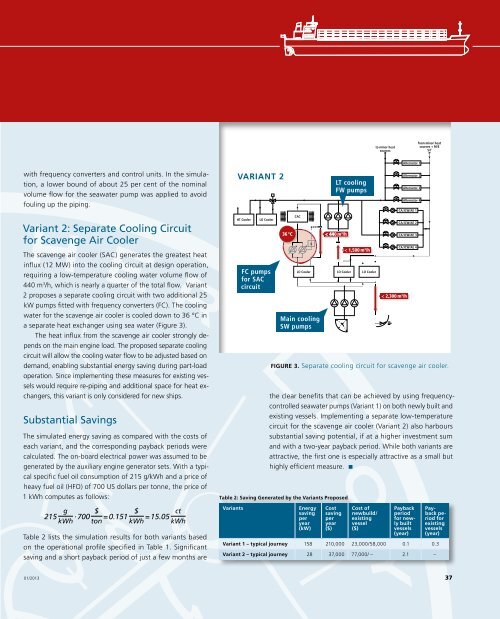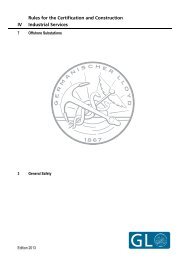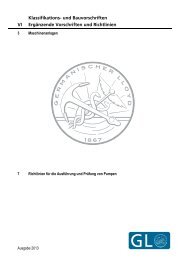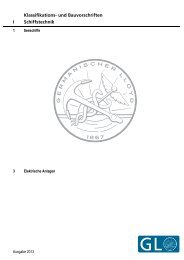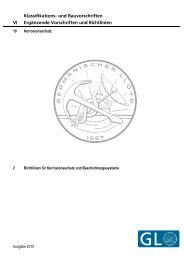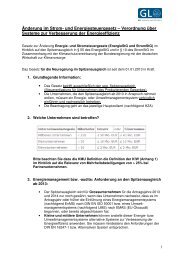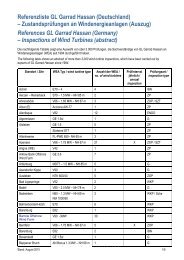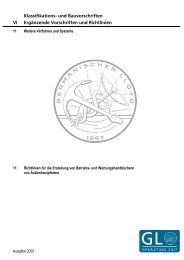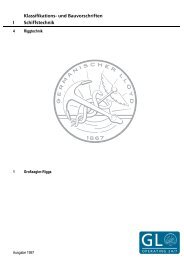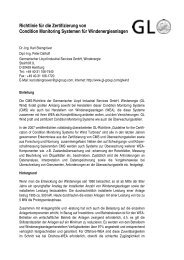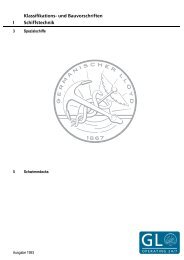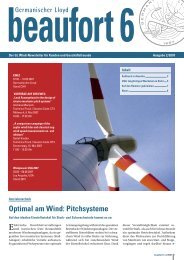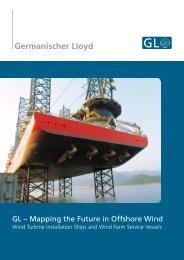Ways to Conserve Energy on Board - DNV
Ways to Conserve Energy on Board - DNV
Ways to Conserve Energy on Board - DNV
You also want an ePaper? Increase the reach of your titles
YUMPU automatically turns print PDFs into web optimized ePapers that Google loves.
<str<strong>on</strong>g>to</str<strong>on</strong>g> minor heat<br />
sources<br />
from minor heat<br />
sources + M/E<br />
S/T<br />
Alterna<str<strong>on</strong>g>to</str<strong>on</strong>g>r 1<br />
with frequency c<strong>on</strong>verters and c<strong>on</strong>trol units. In the simulati<strong>on</strong>,<br />
a lower bound of about 25 per cent of the nominal<br />
volume flow for the seawater pump was applied <str<strong>on</strong>g>to</str<strong>on</strong>g> avoid<br />
fouling up the piping.<br />
Variant 2: Separate Cooling Circuit<br />
for Scavenge Air Cooler<br />
The scavenge air cooler (SAC) generates the greatest heat<br />
influx (12 MW) in<str<strong>on</strong>g>to</str<strong>on</strong>g> the cooling circuit at design operati<strong>on</strong>,<br />
requiring a low-temperature cooling water volume flow of<br />
440 m 3 /h, which is nearly a quarter of the <str<strong>on</strong>g>to</str<strong>on</strong>g>tal flow. Variant<br />
2 proposes a separate cooling circuit with two additi<strong>on</strong>al 25<br />
kW pumps fitted with frequency c<strong>on</strong>verters (FC). The cooling<br />
water for the scavenge air cooler is cooled down <str<strong>on</strong>g>to</str<strong>on</strong>g> 36 °C in<br />
a separate heat exchanger using sea water (Figure 3).<br />
The heat influx from the scavenge air cooler str<strong>on</strong>gly depends<br />
<strong>on</strong> the main engine load. The proposed separate cooling<br />
circuit will allow the cooling water flow <str<strong>on</strong>g>to</str<strong>on</strong>g> be adjusted based <strong>on</strong><br />
demand, enabling substantial energy saving during part-load<br />
operati<strong>on</strong>. Since implementing these measures for existing vessels<br />
would require re-piping and additi<strong>on</strong>al space for heat exchangers,<br />
this variant is <strong>on</strong>ly c<strong>on</strong>sidered for new ships.<br />
Substantial Savings<br />
The simulated energy saving as compared with the costs of<br />
each variant, and the corresp<strong>on</strong>ding payback periods were<br />
calculated. The <strong>on</strong>-board electrical power was assumed <str<strong>on</strong>g>to</str<strong>on</strong>g> be<br />
generated by the auxiliary engine genera<str<strong>on</strong>g>to</str<strong>on</strong>g>r sets. With a typical<br />
specific fuel oil c<strong>on</strong>sumpti<strong>on</strong> of 215 g/kWh and a price of<br />
heavy fuel oil (HFO) of 700 US dollars per <str<strong>on</strong>g>to</str<strong>on</strong>g>nne, the price of<br />
1 kWh computes as follows:<br />
g<br />
215<br />
kWh · 700 $<br />
<str<strong>on</strong>g>to</str<strong>on</strong>g>n = 0.151 $<br />
ct<br />
= 15.05<br />
kWh kWh<br />
Table 2 lists the simulati<strong>on</strong> results for both variants based<br />
<strong>on</strong> the operati<strong>on</strong>al profile specified in Table 1. Significant<br />
saving and a short payback period of just a few m<strong>on</strong>ths are<br />
Figure 3. Separate cooling circuit for scavenge air cooler.<br />
the clear benefits that can be achieved by using frequency-<br />
c<strong>on</strong>trolled seawater pumps (Variant 1) <strong>on</strong> both newly built and<br />
existing vessels. Implementing a separate low-temperature<br />
circuit for the scavenge air cooler (Variant 2) also harbours<br />
substantial saving potential, if at a higher investment sum<br />
and with a two-year payback period. While both variants are<br />
attractive, the first <strong>on</strong>e is especially attractive as a small but<br />
highly efficient measure.<br />
Table 2: Saving Generated by the Variants Proposed<br />
Variants<br />
Variant 2<br />
HT Cooler<br />
LO Cooler<br />
FC pumps<br />
for SAC<br />
circuit<br />
CAC<br />
36 °C 0 m 3 /h<br />
LO Cooler LO Cooler LO Cooler<br />
Main cooling<br />
SW pumps<br />
<str<strong>on</strong>g>Energy</str<strong>on</strong>g><br />
saving<br />
per<br />
year<br />
(kW)<br />
Cost<br />
saving<br />
per<br />
year<br />
($)<br />
LT cooling<br />
FW pumps<br />
< 1,500 m 3 /h<br />
Cost of<br />
newbuild/<br />
existing<br />
vessel<br />
($)<br />
< 2,300 m 3 /h<br />
Alterna<str<strong>on</strong>g>to</str<strong>on</strong>g>r 2<br />
Alterna<str<strong>on</strong>g>to</str<strong>on</strong>g>r 3<br />
Alterna<str<strong>on</strong>g>to</str<strong>on</strong>g>r 4<br />
CA/JCW/AE 1<br />
CA/JCW/AE 2<br />
CA/JCW/AE 3<br />
CA/JCW/AE 4<br />
Payback<br />
period<br />
for newly<br />
built<br />
vessels<br />
(year)<br />
Payback<br />
period<br />
for<br />
existing<br />
vessels<br />
(year)<br />
Variant 1 – typical journey 158 210,000 23,000/58,000 0.1 0.3<br />
Variant 2 – typical journey 28 37,000 77,000/ – 2.1 –<br />
01/2013<br />
37


